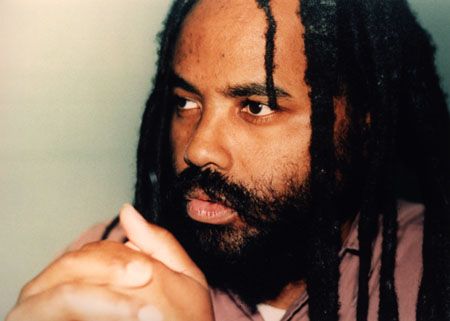Police target journalists
At 5 a.m. in Minneapolis on May 29, Omar Jimenez, a Black CNN reporter wearing press credentials and reporting live on camera on the rebellion against the police murder of George Floyd, was arrested along with the news crew. About a block away, a second CNN crew of white journalists were left unchallenged, even as police rained terror upon the Black demonstrators in both areas. (cnn.com, May 29)
Across the U.S., law enforcement officers have beaten, arrested, gassed, fired upon and bullied journalists into collaboration, while police have rioted to assert their power to carry out extrajudicial executions. They have been most violent toward the few Black journalists they encounter. As of June 11, over 300 journalists have reported receiving some type of police assault. (NPR, June 11).

Imprisoned journalist Mumia Abu-Jamal
Targeting media to avoid accountability
As the uprising took place in Minneapolis following four police officers torturing George Floyd to death on camera, thousands also took to the street in Louisville, Ky., to protest the police killing of Breonna Taylor when they fired live rounds into her home during a no-knock raid on March 13. Louisville became one of the first communities to join the uprising.
Just hours after the arrest of Omar Jimenez, police approached a news crew with CBS affiliate WAVE 3 News in Louisville and fired what WAVE 3 reported as “pepper bullets” directly at the crew. (wave3.com, May 29)
Back in Minneapolis, police began pepper spraying journalists, first backing them up against walls and targeting the press corps rather than individual reporters. Journalists formed human shields and used protective gear to protect themselves from spray and tear gas fired by riot police, despite having shown their press credentials. (latimes.com, May 30)
Police across the U.S. have been clear that their attacks are motivated by the possibility of facing any accountability — collectively or individually — for decades of terror inflicted especially on Black communities. That was clear in Raleigh, N.C., on May 30 when independent journalists reported being heavily gassed as they were struggling to track the types of munitions being used against protesters.
Their concern is that the broad use of tear gas, military style humvees and other first-time use of weapons against civilians around the U.S. may be a trial run for the Republican National Convention in Charlotte, N.C., in August. Independent journalist Charlie McGee reported that “the tear gas is skewing my journalistic rigor.” (tinyurl.com/y8xtd455)
That evening, Copwatch, which tracks police misconduct and violence nationally, reported that Raleigh police ran out of tear gas and had to use expired gas that often contains cyanide, further increasing its toxicity. (indyweek.com) On June 1, a crowd of right-wing vigilantes beat up WHYY journalist Jon Ehrens in the Fishtown area of Philadelphia. In Pittsburgh, a KDKA cameraman was brutally beaten on June 6 while filming a protest.
Journalists who align with police
Under the constant threat of police violence, many news outlets opt to openly align with the police. WRAL, a white-aligned Raleigh-based news station, is well known for a tendency to run police statements as news and film activists’ faces, which are later used in court by prosecutors.
At an event at the University of North Carolina co-sponsored by the Black Congress and Black Student Movement, organizers explicitly requested white journalists not film Black demonstrators without consent. Independent media reported that WRAL refused to comply with this request, even as other outlets chose to honor it. (tinyurl.com/9384067) These and similar incidents highlight the importance of Black journalists and why police may be so eager to target them.
History of attacks on Black journalists
The Root reporter Michael Harriot was with the press corps after a protest on June 4 in Birmingham. He was the sole Black journalist in the group. Fresh from political repression of protesters, police approached the group of journalists, but only arrested Harriot, who was subjected to violence and abuse while in custody. Officers ordered him to remain motionless and tightened cuffs on him to the point they could not remove them without digging wire cutters into his skin. (theroot.com, June 5)
Targeting of Black journalists by police is not a new phenomena as the case of former Black Panther, award-winning journalist and now political prisoner Mumia Abu-Jamal reveals. In the early 1980s, Abu-Jamal was the president of the Philadelphia chapter of the National Association of Black Journalists, and his news broadcasts and commentaries were heard on numerous radio stations.
As a former police commissioner and later mayor, Frank Rizzo, in one of many abuses of power, compiled an over 800-page file on Abu-Jamal in an effort to target him. When the MOVE 9 were arrested and charged with murder of a police officer in 1978, Abu-Jamal was publicly threatened by Rizzo for his reporting on the case.
In 1981, Abu-Jamal was framed for the murder of a Philadelphia police officer and received the death penalty, later overturned in 2001 for constitutional violations. Abu-Jamal’s case, currently in appeals, is once again in the spotlight as Philadelphia activists forced the removal of Rizzo’s statue early in the morning of June 3.
While imprisoned, Mumia Abu-Jamal continues to work as a journalist. In 1994 his commentaries were slated to run during a NPR series on prisons on “All Things Considered.” After NPR bowed to pressure from the Philadelphia Fraternal Order of Police, Abu-Jamal and Prison Radio filed a lawsuit against the station. You can find Abu-Jamal’s work today in Workers World, most recently on prison guards. (tinyurl.com/yaxcq5jo)
Workers World will always be in full solidarity with those under attack for fighting for Black Liberation. Free the Press! Free the People! Free Mumia!

